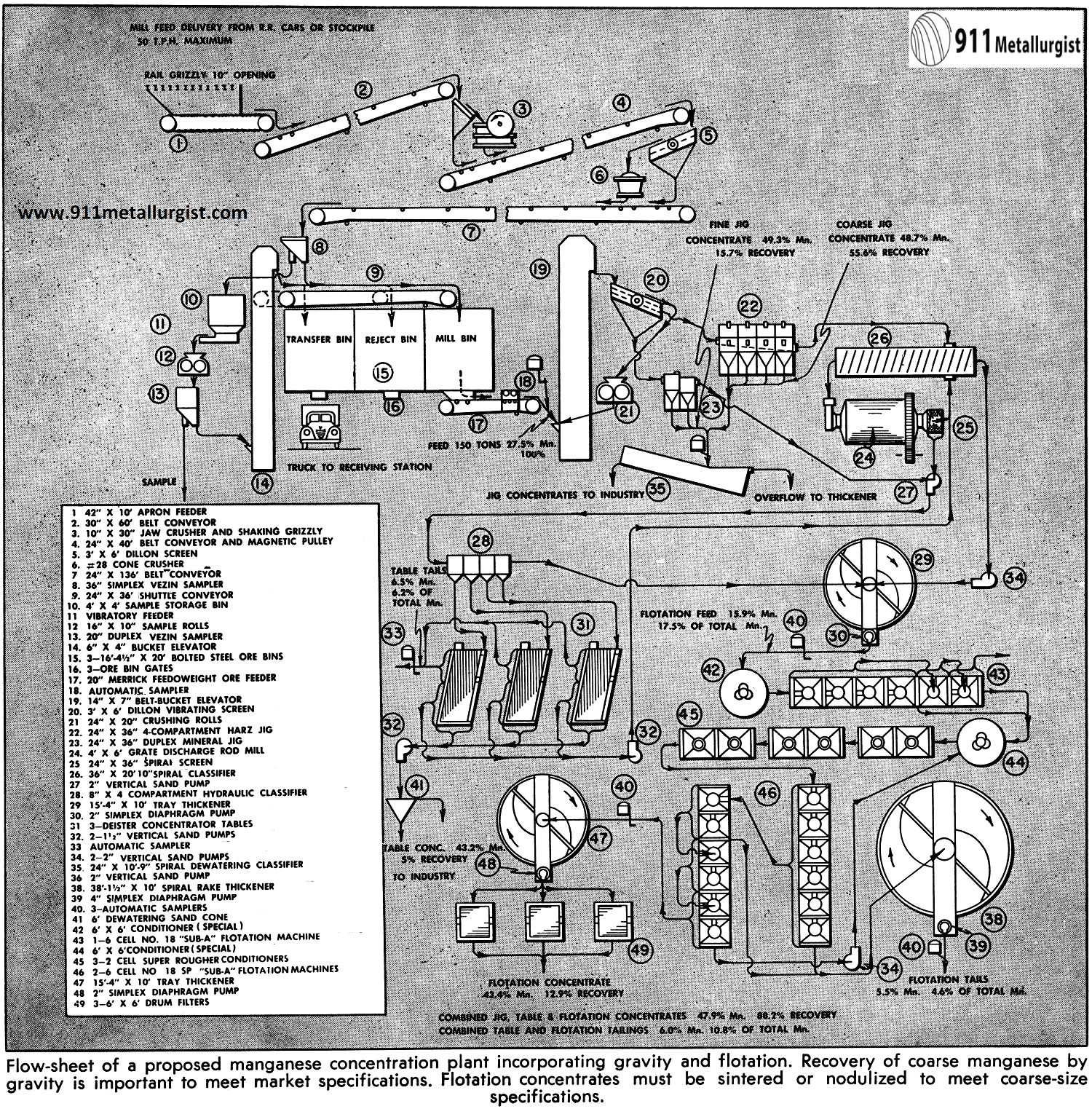Table of Contents
The problem involved in Manganese Ore Processing deals with the production of acceptable specification grades of manganese concentrates at a maximum recovery of the total manganese from ores having variable characteristics. The flowsheet provides for both gravity and flotation with a maximum recovery of the manganese values in a coarse size in the most economical manner by the use of jigs and tables. The coarse concentrate must be up to grade and is immediately acceptable to the steel industry. The fine concentrate produced by flotation is made available for nodulizing or sintering.
The present world situation and lack of high grade manganese ores in the western world has had a pronounced influence on the development and utilization of the lower grade manganese ores. The specification stipulated by the Federal Stockpiling program for manganese ores or concentrates requires a fairly high manganese content with minimum quantities of impurities.
Nodulizing: The forming of rounded shapes by the application to fine coal of a gyratory, rotary, or oscillatory motion, without the use of pressure.
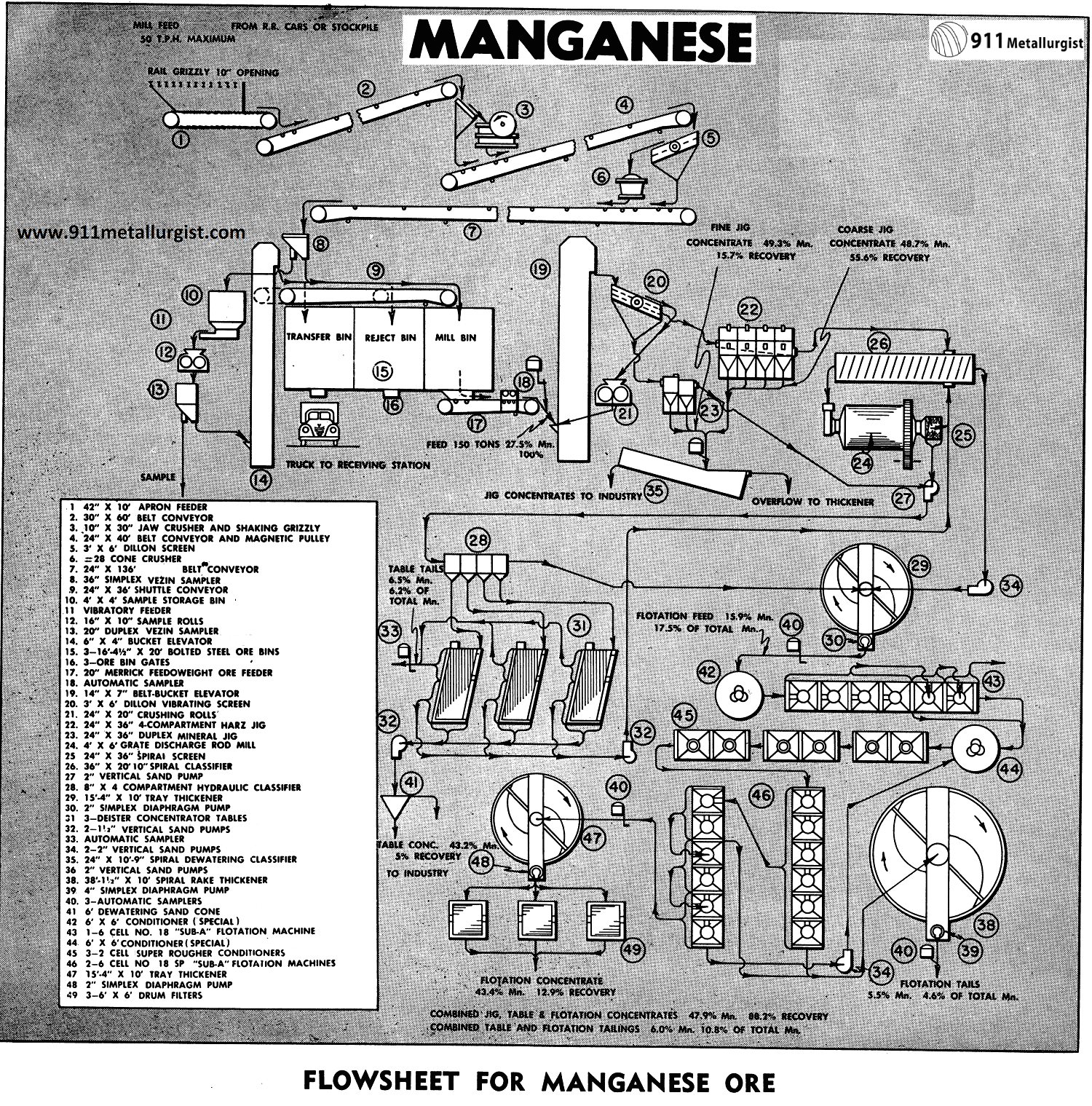
The Manganese Ore Processing Plant
Crushing and Sampling of Manganese Rock
The flowsheet incorporates a conventional multistage crushing plant with a grizzly or screen ahead of both the primary and secondary crushers. The mine run ore is dumped through a 10″ grizzly into a coarse ore bin. The ore is discharged by a Apron Feeder to feed the primary Jaw Crusher. This crusher is equipped with a 2½” opening shaking grizzly to remove the undersize material.
The secondary cone crusher is fed with the oversize product from a 3′ x 6′ Vibrating Screen. This is an example of standard practice of removing all particles as soon as they are reduced to the proper size at each crushing stage. This is important in order to prevent the production of excess fines so easily produced in crushing manganese ores.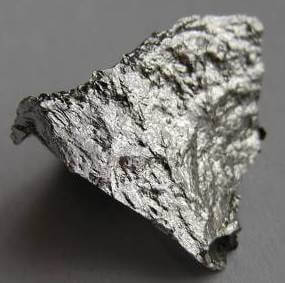
Sampling at this point is done by means of Samplers. They cut an accurate sample and are inexpensive to operate and maintain. The material cut by the initial sampler is fed at a constant rate by means of a vibratory feeder to a set of rolls for further crushing prior to the final sample cut. This results in the most accurate sample possible.
Separate bins are provided to temporarily store the ore until the assays on each lot of ore are known. The mill feed can then be drawn from these bins for proper blending of various types and grades of ore as desired. Ore of different types and grades can also be drawn from these bins for stockpiling a supply of blended ore to provide a uniform ore for continuous mill operation.
The crushing and sampling plant is designed to operate on a one shift per day basis with a capacity of from 400 to 500 tons per shift. The excess crushing capacity is to allow for the stockpiling of excess available ore and to take care of the operation on one shift.
Concentration—Gravity Methods of treating Manganese Ore
The mill feed, drawn from one or more bins, is sampled at the ore feeder discharge to obtain a composite sample for mill control. After elevating, a vibrating screen separates the feed into sizes best suited for the Improved Harz Type Jigs and Selective Mineral Jigs. The coarsest part of the feed goes to the Harz Type Jigs which produces a final concentrate and a tailing. The finer portion of the feed, usually -8 or -10 mesh passes to the Mineral Jig for the recovery of a final concentrate.
The tailings from the Harz Jig are ground in a Steel Head Rod Mill after being dewatered by means of a Crossflow Classifier. The rod grate type mill, equipped with a 10 mesh spiral screen, grinds the jig tailings to minus 10 mesh with a minimum quantity of slimes. The spiral screen removes any plus 10 mesh material which is returned to the classifier. The minus 10 mesh rod mill discharge is combined with the tailings from the Mineral Jig and are pumped to a Hydraulic Classifier for size separation for table fed. Each gravity concentration table treats a separate size range which allows most efficient results. The tables produce a final concentrate, a middling product, which is returned to the rod mill for further grinding, and a sand tailing. The table tailings are either further treated by flotation after regrinding, or are discarded, depending on the assay.
The jig and table circuit can save from 50 to 80% of the manganese, depending on the characteristics of the ore. The grade of the jig and table concentrates is from 44 to 46% metallic manganese. It is essential to recover as much manganese as possible in the gravity concentration section since its milling cost is much lower than in the flotation treatment, and the simple operation is more positive. This demonstrates the principle of “when mineral is free, remove it which is still good metallurgy.
Some ores, however, can only be treated by flotation to a greater extent in order to make an overall economic recovery.
Manganese Ore Concentration by Flotation
The slime fraction of the ore overflowed by the hydraulic classifier and by the rod-mill spiral classifier is thickened in a Spiral Rake Tray Thickener for treatment by flotation.
The flotation circuit is designed to treat three classes of manganese ores.
- Those ores with a high calcite gangue.
- Those ores with mixed calcite and siliceous gangue.
- Those ores with a highly siliceous gangue.
Types 1 and 2 ores require a prefloat treatment to remove the calcite as a froth. The calcite must be removed ahead of the manganese since if left in the circuit it will float with the manganese, thereby giving a low grade manganese concentrate. Tailings from the calcite prefloat circuit are then further treated by flotation, floating the manganese as a concentrate.
The reagent combinations used are generally the same as have been worked out in recent years by the U. S. Bureau of Mines. Reagent consumption is high and varies with each type and grade of ore.
Careful and complete conditioning is a very important step in manganese flotation. Here we use a Special Super-Agitator and Conditioner for the proper mixing of the reagents into the pulp plus Super Rougher cells as conditioners. This provides the intense mixing for proper flocculation so essential for manganese flotation. The amount of aeration is easily controlled during the conditioning.
Thickening of the concentrates improves the filtration rate and is an important step. A drum filter is used in preference to a disc type because of the slimy nature of the flotation concentrate.
A nodulizing or sintering step may be necessary for the further treatment of the flotation concentrates. This step produces nodules or a sinter product acceptable to industry and the grade of manganese is also materially increased by such treatment.
MODERN MANGANESE PLANT
Manganese Ore Treatment Summary
This flowsheet is designed to produce a maximum amount of the manganese in a coarse form which will be marketable without the further and high cost of nodulizing or sintering. The gravity concentration sections do this. Since the reagent costs for manganese flotation are high and in direct proportion to the amount of flotation concentrates produced, preceding flotation by gravity concentration results in maximum recovery with lowest cost. This flowsheet follows the fundamental rule of metallurgy—recover your mineral as soon as free and as coarse as possible.
Recovering Manganese using Gravity
As the problem involved stock piling of the minus 20-mesh material for selective flotation recovery under more favorable market conditions, the equipment selected at this stage consisted only of gravity concentration and sizing equipment to produce a partially- concentrated product which could be economically shipped to the purchaser. A typical manganese oxide ore stipulated that it contain not more than 10% minus 20-mesh material.
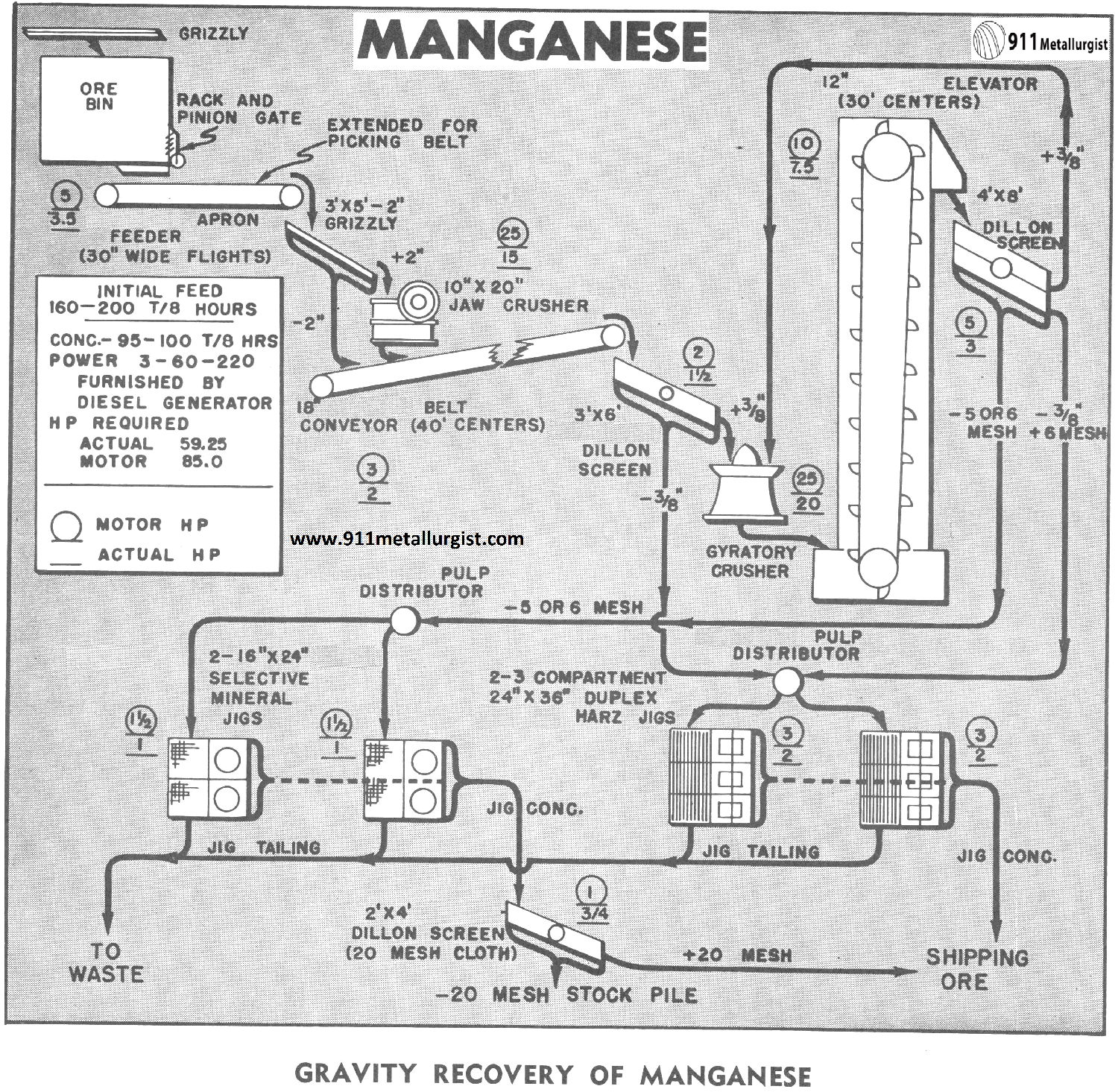
The Manganese Gravity Recovery Circuit Flowsheet
Ore Bin and Feeder
Mine ore is dumped through an 8″ Grizzly into a coarse ore bin provided with a rack and pinion gate for discharging the ore to the Apron Ore Feeder which is built to resist high abrasion and the stress of sudden impact. A feeder with 30″ wide flights was chosen in this case and a sufficient length was recommended for the feeder to allow for a portion of it being used as a picking belt. The availability of low-cost labor makes it possible to discard considerable waste rock at this point.
Grizzly
Primary sizing is done by means of a 3’x 5′ Grizzly with 2″ openings. This Grizzly could be made into the vibrating type if desired, obtaining its motion from the pitman of the crusher. Grizzly undersize passes to a conveyor and oversize to the primary crusher.
Primary Manganese Crusher
A 10″x 20″ Forced Feed Jaw Crusher reduces the oversize from the Grizzly to a minus 2″ product. Undersize joins the Grizzly undersize on a conveyor to the first screen.
Screen No. 1
The single deck, 3’x 6′ Vibrating Screen removes the minus 3/8″ product from the secondary crusher feed. The minus 2″ plus 3/8″ product is fed to the secondary crusher, the minus 3/8″ screen undersize becoming part of the feed to the jigs.
Secondary Manganese Crusher
Several excellent gyratory crushers are on the market. A 1′-8″ Traylor Gyratory Crusher unit was selected to reduce the minus 2″ plus 3/8″ feed to all minus 3/8″- At this point in the flowsheet it would be possible to utilize crushing rolls which tend to produce slightly less fines than a gyratory crusher. However, due to the greater reduction ratio of the crusher and the difficulty in transporting crushing rolls to the millsite, the gyratory crusher was recommended.
Bucket Elevator
Crusher discharge is fed to the boot of a 12″ Belt Bucket Elevator, in this instance arranged with a 30′ center distance between head and tail pulleys.
Screen No. 2
A double-deck, 4’x 8′ Vibrating Screen produces three products from the elevator discharge.
- The plus 3/8″ ore, upper screen cloth oversize, is returned to the gyratory crusher.
- The minus 3/8″ plus 6-mesh material, second screen cloth oversize, becomes part of the feed to the Harz Jigs.
- The minus 6-mesh product, second screen cloth undersize, becomes the feed to the two 16″x 24″ Selective Mineral Jigs.
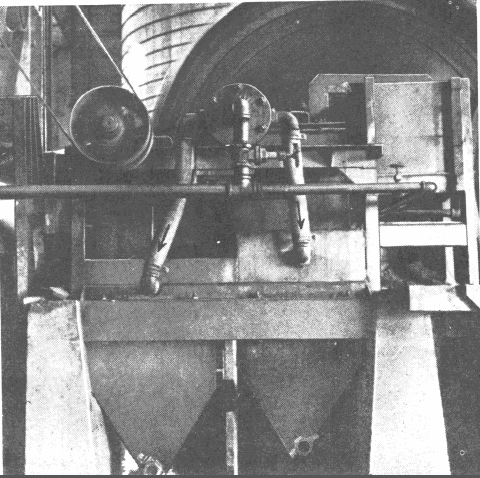
Ratios of concentration as high as 97,000 to 1 have been made In a Selective Mineral Jig. Far continuous discharge of precious metal concentrates, Dowsett Valves with locking arrangement may be used on hutch discharges.
Pulp Distributors
Two Self-Rotating Pulp Distributors are used. One distributes the minus 6-mesh material to the Mineral Jigs, and the second distributes the minus 3/8″ plus 6-mesh product to the Harz Jigs.
Selective Mineral Jigs
Two Duplex Selective Mineral Jigs concentrate the minus 6-mesh manganese ore. Tailings from these jigs are sent to waste. The high-grade product produced by the jigs’ selective action is sent to further screening.
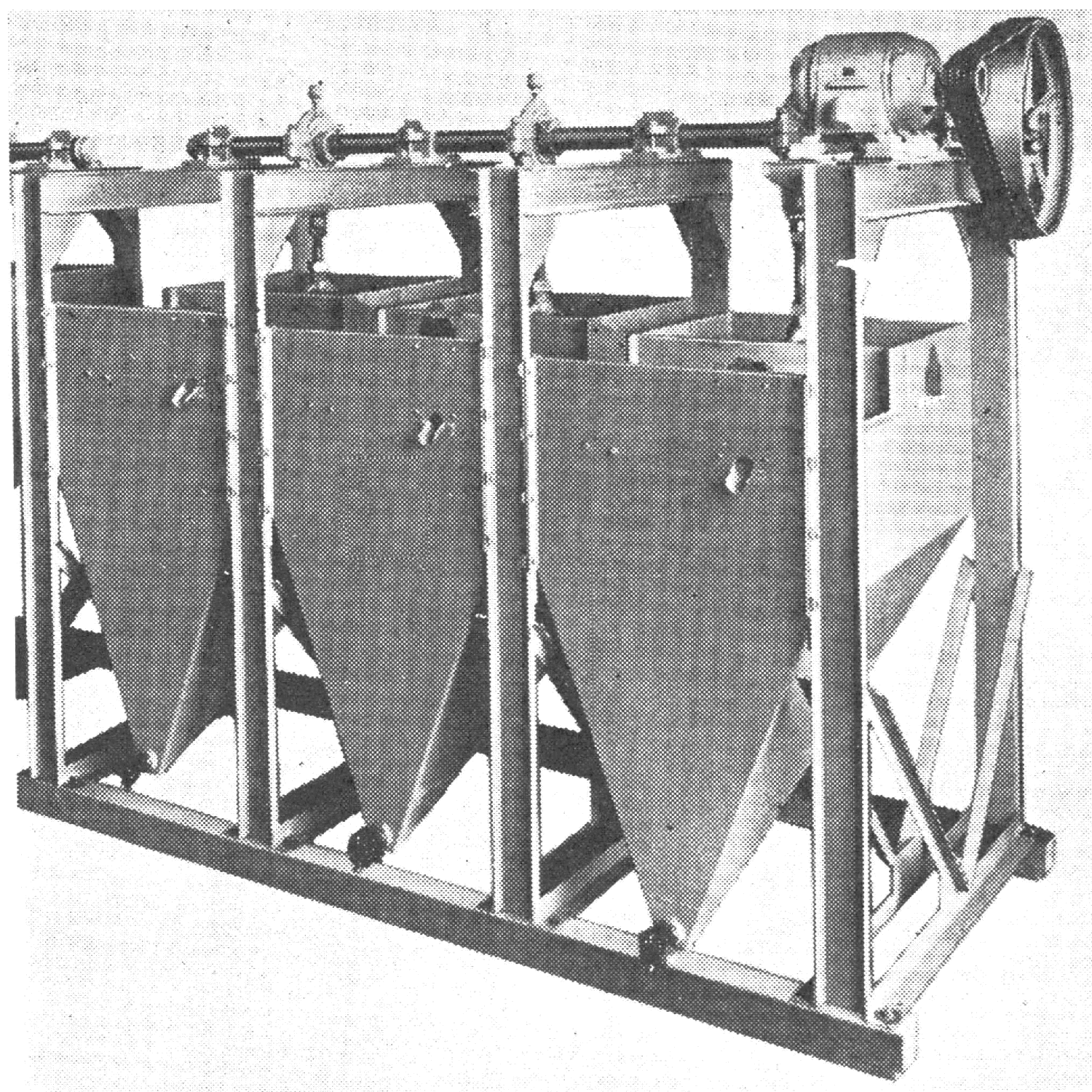
Screen No. 3
As the market requires that not more than 10% of the shipping ore is minus 20-mesh, the selective jig concentrates are passed over a single-deck, 2’x 4′ Dillon Vibrating Screen, with 20-mesh screen cloth. The plus 20-mesh screen oversize becomes shipping ore and the minus 20-mesh manganese is stock piled for future marketing. Present briquetting costs do not permit this method of preparation for market at this time.
Harz Type Jigs
The minus 3/8″ undersize from Screen No. 1, together with the minus 3/8″ plus 6-mesh product from Screen No. 2 are concentrated by two 3-compartment, (Improved Harz Type) Jigs. Units with 3 compartments were chosen to give ample capacity to produce a high-grade manganese product. Tailings from these jigs go to waste and the concentrates become shipping ore.
Manganese Process Beneficiation Summary
This flowsheet is based upon the principle of recovering the mineral as soon as it is free from the gangue. This is essential in the treatment of manganese ores due to their tendency to slime readily. Note that both the motor horsepower provided for each machine and the actual horsepower required is shown. The motor horsepower figures are enclosed in circles and the horsepower-consumed figures are underlined.
Manganese Concentration Plant
Manganese Market Specifications
The ordinary specifications for marketing manganese ore are as follows (dry ore basis):
Mn, minimum…………………………………………………………………………………………….48.0 per cent
Fe, maximum………………………………………………………………………………………………..6.0 per cent
P, maximum………………………………………………………………………………………………..0.12 per cent
Si02 + Al2O3, maximum………………………………………………………………………………11.00 per cent
Non-ferrous impurities, maximum………………………………………………………………….1.00 per cent
Size analysis shall show all minus 1 inch and not more than 25 per cent to pass a 20 mesh screen.
Production Problems
While managanese ore is not a non-metallic, the application of flotation to its beneficiation is similar to that used for the non-metallic ores. Non-metallic reagents are used to float non-metallic impurity minerals such as calcite, and other non-metallic reagents can be used to concentrate the manganese mineral and reject silica and alumina minerals as a tailing. Manganese is a critical mineral in America and the development of new methods of beneficiation is highly desirable for our national defenses. While much investigational work has been carried out by the U.S. Bureau of Mines and others, there is still a need for more efficient reagents to make many ores economically amenable to the flotation process.
Reagent Combinations
(1) Carbonate-Gangue Ores—The carbonate gangue, such as calcite, is floated first with fatty acid, using an alkaline pulp and a starch or yellow dextrine to inhibit the manganese oxide. The pulp is then acidified and the manganese oxide floated with an emulsion of crude Tall oil, and heavy fuel oil emulsified in hot water with petroleum acids such as Oronite wetting agent S or Oronite sulfonate L.
(2) Siliceous- and Aluminous-Gangue Ores—These are floated direct in a sulphuric acid circuit, using the above fuel oil emulsion.
Source: This article is a reproduction of an excerpt of “In the Public Domain” documents held in 911Metallurgy Corp’s private library.

